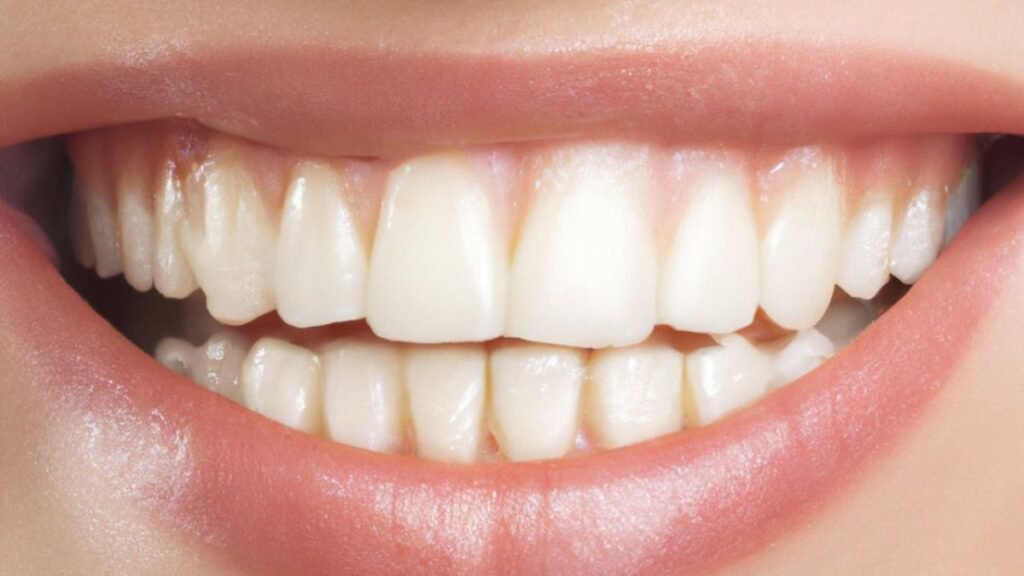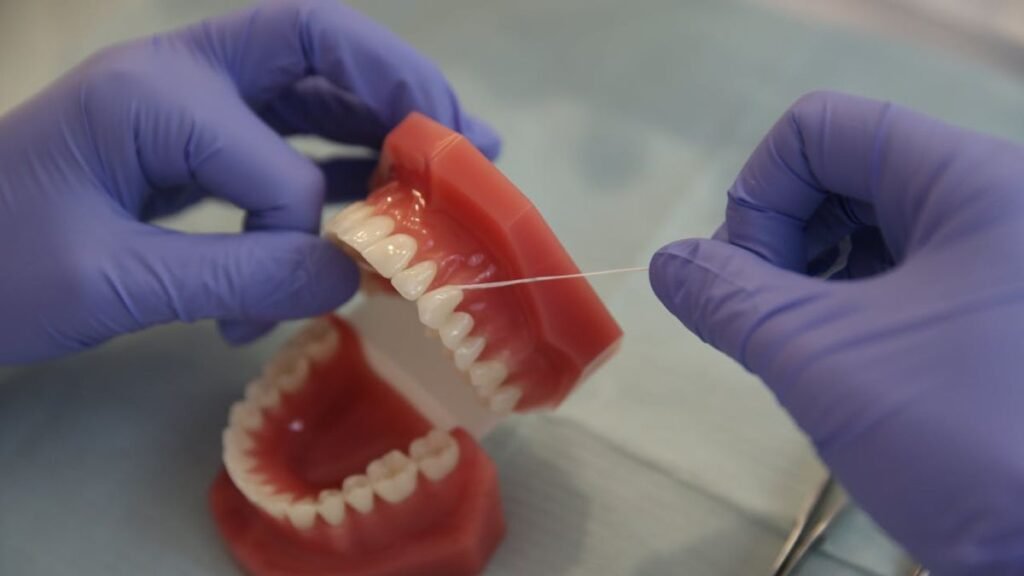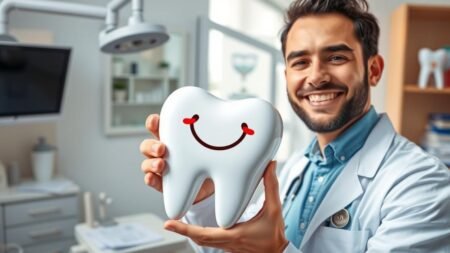Ever felt a sharp pain in one tooth while flossing? It’s a common problem that can worry you. But knowing why it happens is the first step to feeling better and keeping your mouth healthy. This article will look at why you might get a toothache from flossing and how to fix it.
Flossing is key to good oral health, but it can hurt sometimes. Why does this happen, and how can you stop the pain? Let’s explore the reasons and solutions for that one tooth that always seems to hurt when you floss.
- Why One Tooth Hurts When I Floss
- New to Flossing: Pain and Adjustment Period
- The Connection Between Tooth Decay and Flossing Pain
- Gum Disease and Its Role in Flossing Discomfort
- Proper Flossing Techniques to Minimize Pain
- Tooth Sensitivity: Causes and Treatment Options
- When to Seek Professional Dental Care
- Conclusion
Why One Tooth Hurts When I Floss
Feeling pain in just one tooth while flossing is common. It can come from many dental health issues. It’s important to understand and fix these problems quickly to keep your mouth healthy.
Common Symptoms and Pain Patterns
The pain from flossing can feel sharp or dull. Some people also get sensitive to hot or cold foods. These signs might mean you have tooth decay, gum disease, or a root canal infection.
When to Be Concerned About Tooth Pain
If the pain doesn’t go away or gets worse, it’s a red flag. You should see a dentist if the pain lasts more than a few days or gets more intense. Ignoring it can lead to bigger problems like tooth decay or gum disease.
Impact on Daily Oral Care
Pain from flossing can make you skip flossing. Not flossing well enough can make dental problems worse. Fixing the pain is key to keeping your teeth and gums healthy.
New to Flossing: Pain and Adjustment Period
If you’re new to flossing, you might feel some pain or discomfort. This is normal as your teeth and gums get used to it. The pain can come from flossing too hard, which can hurt your gums and make them bleed.
Tooth sensitivity can also happen, making your teeth hurt. This is because the enamel wears off, exposing the nerves. How much pain you feel depends on your genes.
Dental decay in areas where you floss can also cause pain. Loose fillings or crowns can hurt too, as they expose nerves. Even braces or retainers can be uncomfortable, more so after adjustments or if you’re not flossing right.
But don’t worry, the pain usually goes away as your gums get used to flossing. It’s best to move the floss gently and slowly to avoid hurting yourself. If the pain doesn’t go away, it might mean you have a dental problem that needs a dentist’s help. Sticking to the right technique and flossing regularly will help you avoid pain and keep your mouth healthy.
| Causes of Flossing Pain | Remedies |
|---|---|
| Vigorous flossing leading to soreness and bleeding gums | Use gentle, slow flossing movements |
| Enamel loss exposing nerves | Consult a dentist for treatment options |
| Dental decay in flossing areas | Improve flossing technique and seek dental care |
| Loose fillings or crowns exposing nerves | Have dental work repaired by a professional |
| Braces or retainers causing discomfort | Adjust flossing method to accommodate dental work |
With the right flossing technique and a bit of patience, the pain will go away. You’ll be on your way to better oral hygiene and a healthier smile.
The Connection Between Tooth Decay and Flossing Pain
Flossing can hurt if you have tooth decay. Cavities make teeth sensitive, causing pain when you floss. Knowing how to spot cavities and how they affect flossing can help prevent and treat issues.
Signs of Cavity Development
Tooth decay starts with small signs like sensitivity to cold or hot foods. You might also feel pain when eating sweet or crunchy foods. Visible holes or discoloration in teeth are clear signs of decay. Severe pain could mean a tooth abscess, needing immediate dental care.
How Decay Affects Flossing Sensitivity
Decay exposes dentin, making teeth more sensitive. This sensitivity makes flossing painful. Inflamed gums from decay also add to the discomfort.
Prevention and Treatment Options
Good dental care can prevent decay and reduce flossing pain. Brush with fluoride toothpaste, floss daily, and see your dentist regularly. If flossing hurts, see your dentist. They might fix it with a filling or more, depending on the decay.
| Preventive Measures | Treatment Options |
|---|---|
| Brush with fluoride toothpasteFloss dailySchedule regular dental check-ups | FillingsCrownsRoot canalsDental extraction |
By tackling the root causes of flossing pain and practicing good dental care, you can keep your mouth healthy and pain-free.

Gum Disease and Its Role in Flossing Discomfort
Gum disease, or gingivitis, can make flossing painful. Inflamed and sensitive gums can hurt when you floss. It’s important to understand how gum disease affects flossing to keep your mouth healthy.
Gum disease happens when plaque and tartar build up on teeth. This irritates the gums, causing them to swell, turn red, and feel tender. Bleeding when you brush or floss is another sign. If not treated, it can get worse and harm the teeth and gums.
Flossing is key to keeping your teeth clean. It gets rid of plaque and food bits in tight spaces. But for those with gum disease, it can make things worse, making it hard to floss.
Seeing a dentist is the first step to ease flossing pain. They can clean your teeth and gums, reducing inflammation. They might also suggest special mouthwashes or treatments.
Using the right flossing technique can also help. Move the floss gently up and down, without snapping it. Using a soft toothbrush and brushing softly can also make oral care less painful.
Knowing how gum disease affects flossing helps you take care of your teeth better. By addressing the gum disease, you can make flossing less painful and keep your mouth healthy.
| Statistic | Value |
|---|---|
| Percentage of adults with gum disease | 50% |
| Percentage of adults with severe gum disease | 9% |
| Percentage of Americans who floss daily | 16% |
| Smoking as the most significant risk factor for gum disease | True |
| Gum disease as the primary reason for tooth loss in adults | True |
Proper Flossing Techniques to Minimize Pain
Keeping up with the right flossing technique is key for good oral hygiene and less pain. By following a simple guide and picking the best flossing products, you can get rid of plaque. This makes your brushing and flossing routine better.
Step-by-Step Flossing Guide
- Start with about 18 inches of floss to have enough.
- Slide the floss gently between your teeth, avoiding snapping or pulling.
- Curve the floss around each tooth’s base, cleaning the whole surface.
- Use a gentle back-and-forth motion to remove food and plaque.
- Don’t forget to floss behind your back teeth, a common missed spot.
Choosing the Right Flossing Products
The right flossing product makes a big difference. Try waxed floss for easier movement or floss picks for better control. Look for products with the American Dental Association (ADA) Seal of Acceptance. They’re safe and effective.
Common Flossing Mistakes to Avoid
- Don’t use too much force or sawing motion, which can hurt gums.
- Make sure to floss behind your back teeth, where plaque and food hide.
- Don’t reuse floss, as it spreads bacteria and germs.
- Never skip flossing, as plaque hardens and becomes harder to remove.
By using these proper flossing techniques, you can remove plaque and keep your mouth healthy and pain-free. Make flossing a daily habit to keep your smile shining and teeth strong.
Tooth Sensitivity: Causes and Treatment Options
Tooth sensitivity is a common dental issue. It can cause discomfort during everyday activities like flossing. This sensitivity is often caused by exposed dentin or worn enamel.
Several factors can contribute to tooth sensitivity. These include aggressive brushing, consuming acidic foods and drinks, and teeth grinding. Symptoms often include a sharp, stinging pain when consuming hot or cold items, as well as during flossing.
Fortunately, there are various treatment options available. These can help manage tooth sensitivity and alleviate discomfort. Some common approaches include:
- Using desensitizing toothpaste that contains ingredients like potassium nitrate or strontium chloride to block pain signals from the nerves.
- Applying fluoride varnishes or gels to strengthen enamel and reduce sensitivity.
- Undergoing professional treatments like dental bonding or crowns to cover exposed dentin.
- Addressing any underlying dental issues, such as cavities or gum disease, that may be contributing to sensitivity.
Maintaining good oral hygiene habits is also important. This includes gentle brushing and daily flossing. If the discomfort persists or worsens, it’s important to consult with a dentist. They can help determine the root cause and explore the most suitable treatment options for your specific needs.
| Cause of Tooth Sensitivity | Prevalence |
|---|---|
| Aggressive brushing | Affects up to 8% of people |
| Teeth grinding | Impacts around 10% of the population |
| Gum disease | Affects approximately 47% of adults |
| Improper brushing and flossing | Up to 12% of people experience sensitivity due to this |
| Dental procedures | Temporary sensitivity affects around 30% of patients |
| Teeth whitening treatments | Causes sensitivity in about 1 in 5 individuals |
When to Seek Professional Dental Care
If you feel pain while flossing, it’s time to see a dentist. This pain might mean you have a dental problem that needs a doctor’s help. Look out for these signs to know when to go:
- Severe or prolonged pain when flossing
- Visible signs of tooth decay or gum disease
- Loose or damaged dental restorations, such as fillings or crowns
- Symptoms of gum inflammation, like redness, swelling, or bleeding
A dentist can check your teeth and gums. They can find out why you’re in pain and suggest the best treatment. This could be a simple cleaning or something more like a root canal or dental implants.
Going to the dentist regularly is key to keeping your mouth healthy. It helps prevent problems like tooth decay and gum disease. If you’re in pain while flossing, don’t wait. Schedule an appointment with a dentist right away.
| Dental Service | Description |
|---|---|
| Root Canal | A procedure to repair and save a badly damaged or infected tooth by removing the pulp, cleaning the inside, and sealing it. |
| Dental Implants | Artificial tooth roots that are surgically placed into the jawbone to replace missing teeth and provide a strong foundation for permanent or removable replacement teeth. |
If you have severe tooth pain, Granbury Endodontics can help. They specialize in root canal therapy to fix the problem and make you feel better. If you need dental care, schedule an appointment today.
Conclusion
Pain in one tooth while flossing can happen for many reasons. These include bad flossing habits, tooth decay, gum disease, or sensitive teeth. If you feel pain, it’s important to know it’s not always bad.
Keeping your mouth clean and using the right flossing techniques are key. Regular dental visits are also important. This helps prevent and fix tooth pain and sensitive teeth.
Going to the dentist often and fixing dental problems quickly can help. It keeps your gums healthy and your mouth feeling good. With the right steps, you can make flossing pain-free and keep your teeth healthy.
FAQ
What are the common causes of pain in one tooth while flossing?
Pain in one tooth while flossing can come from many sources. These include bad flossing habits, tooth decay, gum disease, and tooth sensitivity.
What are the typical symptoms and pain patterns associated with this issue?
Symptoms include pain in one tooth and sensitivity to hot or cold. You might also feel pain when eating. If the pain gets worse, it could mean a bigger problem like tooth decay or gum disease.
When should I be concerned about tooth pain while flossing and seek professional help?
If you have constant or severe pain, see a dentist. Also, if you notice decay, loose fillings, or signs of gum disease, get help. A dentist can find the cause and suggest the right treatment.
How can improper flossing technique contribute to pain?
New flossers might hurt themselves because they use too much force or the wrong motion. It’s important to floss gently and slowly to avoid pain.
How does tooth decay lead to pain during flossing?
Tooth decay can make flossing painful by exposing sensitive parts of the tooth. Look out for sensitivity to cold or hot, pain while eating, and localized pain.
What role does gum disease play in flossing discomfort?
Gum disease, or gingivitis, can make flossing painful because of inflammation and sensitivity. Signs include bleeding, swollen gums, redness, tenderness, and bad breath.
How can tooth sensitivity contribute to pain when flossing?
Tooth sensitivity can cause pain during flossing because of exposed dentin or worn enamel. Causes include hard brushing, acidic foods, and grinding teeth. You can try desensitizing toothpaste or see a dentist for more help.








